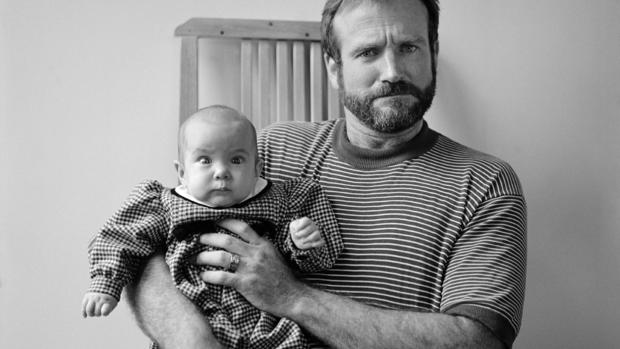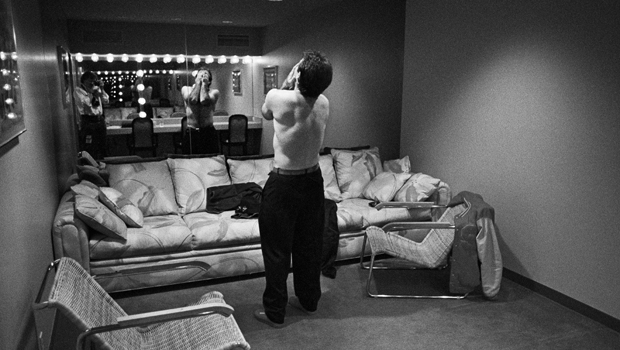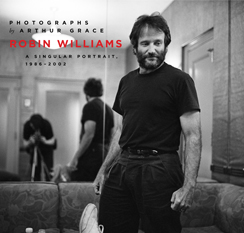Robin Williams: An intimate portrait
Robin Williams was full of life. Now, almost two years after his death, we have a chance to see Williams as we've never seen him before. Tracy Smith has his Life In Pictures:
The images of his performance onstage are almost like those of a hummingbird captured in flight: Mania and mayhem, frozen in time.
In 1986, Robin Williams was a man who, it seemed, could do everything but stop.
Arthur Grace was a photographer assigned to cover him for Newsweek magazine. And not long after Grace's cover shot hit the newsstands, Williams asked him to stick around and, basically, help document his life.
"We just hit it off," Grace said. "We got along well together and respected each other."
"If you could boil it down, what do you think it was that made the two of you click?" asked Smith.
"We were both children! He never once said to me, 'Don't shoot this,' or 'You can't photograph that,' or 'You've done enough.' Never one time, as long as I knew him, did that ever happen."
So for close to 30 years, Grace shot everything ... in every waking and non-waking hour ... in places far from public view.
He captured the calm before the storm.
Grace says that in the moments before a standup performance, Williams would drift into what seemed like another world. He would get very quiet, almost sleepy.
"They call it a Zen-like state," Grace said. "He just almost fell asleep. He was just looking down, his arms down just really quiet, looking down, his eyes closed. And I'm going, should I wake him up? I mean, should I poke him or something?
"And all of a sudden, you'd hear the announcer come on: 'Ladies and gentlemen, please welcome Robin Williams!' And as soon as he'd say, 'Williams,' his eyes came open. And he was off like a shot."
"He ran on the stage like he was shot from a cannon. He went from zero to 60, zero to 100 as soon as they mentioned his name. I've never seen anything like it," Grace said.
And, after 90 minutes of superhuman performance, Williams' assistant would meet him backstage with a plastic bag to collect his sweat-drenched shirt.
Williams wasn't Arthur Grace's first celebrity assignment, or his most famous. As a press photographer, Grace spent years covering presidents, at the White House and on the road.
He got politicians running for office, and journalists running to meet deadlines, like our CBS colleague Lesley Stahl in 1980.
He photographed John Wayne in a tank, and Jacqueline Onassis in a pensive mood.
But to him, none was more fascinating than Robin Williams -- a standup comedian-turned-movie star.
His portrayal of an elderly woman in 1993's "Mrs. Doubtfire" was a stretch, personally and physically.
But to Grace, Williams' turn as Matt Damon's therapist in 1997's "Good Will Hunting" took things to a new level. "I'd never seen Robin so focused on a movie," he said.
In 1997, Grace was in Boston on the set, shooting still photos that were used to promote the film.
"He had to use a Boston accent; that was part of it, so he was into it, totally into it. He was studying with his dialect coach in his hotel room all weekend. And he delivered one of the great monologues -- two pages of script -- on film that's still remembered."
For this role, Williams got his fourth Academy Award nomination, and his first win.
On Oscar night, Arthur Grace hovered nearby, snapping everything with a small pocket camera. He described Williams that night as "otherworldly, almost. I was watching in real time somebody live out a dream."
The party ended early the next morning at Williams' hotel suite.
"I noticed the Oscar was still on the little table next to, I think it was a Junior's Deli bag that was half-open. So that was the last picture I shot and let myself out. And that was Oscar night."
He says that the pictures he'd taken of Williams number in the thousands.
Grace, who now lives on his boat in Los Angeles, says he imagined he and Robin would go through all the pictures together as old men, but it was not to be.
The last time he saw Robin was in late 2013, about six months before he died. He just seemed to be quieter, didn't have the same energy that I remember."
"But you didn't get the sense that there was anything wrong?"
"Wrong with him? No. No. No. No. No. Not at all."
- Robin Williams dead at 63 (08/11/14)
- Robin Williams' death leaves loved ones, fans stunned (08/12/14)
- Robin Williams' 10 most memorable movie roles (08/11/14)
- How Robin Williams forever changed the world of stand-up comedy (08/12/14)
- Gallery: Robin Williams 1951-2014
- Complete CBSNews.com coverage: Robin Williams
In the days after Williams' suicide at 63, Arthur Grace was swamped with photo requests, but he ignored them all.
When asked if he could look at the photos, Grace replied, "No. I didn't do anything then. It's too hard. It's too hard, still."
Now, as a tribute, he's now compiled his favorites into a book.
In it are photos of Williams at his happiest around his kids. Grace captured the Robin Williams that the rest of the world rarely saw: Intimate moments with his children while they were young, like bath time in 1995.
A bedtime story with daughter Zelda, and a quiet cuddle with his sleepy son, Cody, at the end of the day.
When asked how he remembers Williams, Grace said, "Oh, the most interesting guy I ever met in my life by far. We shared some incredible times together. And they're not gonna be repeated with anybody else."
Of all the photos he took, this one, he says, is his favorite: Robin Williams at the end of a show in 1986 -- exhausted, exuberant, and victorious.
For more info:
- "Robin Williams: A Singular Portrait, 1986-2002" by Arthur Grace (Counterpoint)
- Arthur Grace Photography




